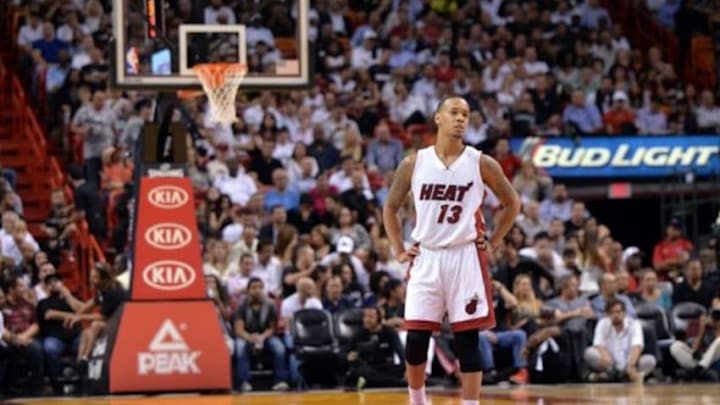Early Saturday, the Miami Heat sent out the news via the team’s official Twitter account, an unexpected roster move that no one saw coming:
The two players sent to the NBA D-League, Shabazz Napier and Hassan Whiteside, represented very different ends of the spectrum in terms of playing time and productivity.
While Whiteside had just signed with Miami in mid-November after being waived by the Memphis Grizzlies, Napier was a valued draft pick that had been entrusted with significant minutes in the rotation. The rookie out of UConn had been on the floor during the closing minutes of tightly-contested games.
In fact, as starting point guard Norris Cole watched from the bench, it was Napier who was often entrusted with running the offense as Miami tried to close out games with a victory.
And now he and Whiteside would be playing with Miami’s D-League affiliate, the Sioux Falls Skyforce, at least for the foreseeable future.
The move makes sense for Whiteside, a raw 7-footer that had only seen nine minutes of action over the course of three games. He’s clearly a long-term project and, as reported by the Sun Sentinel’s Ira Winderman, his designation to Sioux Falls is to give the Birdman a chance to soon take flight in Miami:
Move with Whiteside indicates Chris Andersen likely on the verge of returning from his sprained ankle.
— Ira Winderman (@IraHeatBeat) December 13, 2014
Andersen severely sprained an ankle and had missed the last nine games. Since then, the Heat’s weak interior defense has been thoroughly exposed and the team has struggled through their worst stretch of the season.
More from Hoops Habit
- The 5 most dominant NBA players who never won a championship
- 7 Players the Miami Heat might replace Herro with by the trade deadline
- Meet Cooper Flagg: The best American prospect since LeBron James
- Are the Miami Heat laying the groundwork for their next super team?
- Sophomore Jump: 5 second-year NBA players bound to breakout
As for Napier, despite his progress there had been signs that he’d fallen somewhat out of favor with the Heat coaching staff. He had played in all 23 games as a reserve, scoring a career-high 17 points in a November 20 loss to the L.A. Clippers.
But in his last nine games, Napier failed to score in double-digits and went scoreless in four of those contests. His time had fluctuated during that span, peaking at 32 minutes (on December 3, in a loss to the Hawks) and then dropping to a total of 25 minutes over the last three games combined.
Napier hadn’t earned a starting spot, even when Cole missed a number of games due to injury and, later, illness. The Heat’s backcourt rotation has been in flux all season, with Cole and Dwyane Wade the designated starters since opening night.
But Wade missed a number of games (due to a hamstring injury) and Mario Chalmers — who had been thriving in a new role as the team’s sixth-man — would start at the 2-guard. Shannon Brown, no longer with the team to make room for Whiteside, even started two games ahead of the rookie Napier.
Will Napier’s designation impact the Heat negatively? The reality is that it might not have any impact whatsoever, despite how fans will undoubtedly react to the news. Cole and Wade will continue starting, barring any injury.
Since Wade’s return, Chalmers has gone back to this sixth-man role (albeit with less success) and Napier gets left out of the rotation by default. Getting the young player some much-needed playing time — as a starter, no less — will only be possible as a member of the Skyforce and not with the Heat.
Of course, the move is far from a done deal. He can be brought up at any point, especially in the event that another guard should succumb to injury.
The question in the long-run is whether the team chooses to keep Cole, a restricted free agent at the end of the season. As a starter, he’s played very inconsistently and hasn’t shown that he’s worth a significant financial commitment. Moreover, the Heat’s plans revolve around keeping salary cap flexibility until the summer of 2016.
Only two players (Chris Bosh and Josh McRoberts) have contracts that continue past the ’15-’16 season and re-signing Cole would conflict with that plan.
The Heat have three options: 1) they can trade Cole at some point this season, 2) they can give him a one-year deal he’d be willing to accept after this season ends (like Greg Monroe‘s deal with Detroit) or, 3) simply let him walk, deciding he’s not part of their long-term plans.
In the case of scenario one or three, the continued development of Napier is crucial to ensure there isn’t a significant loss of production from the point guard position.
While the Napier acquisition in the 2014 NBA Draft had been met with some criticism (partly because of the endorsement of LeBron James, no longer with the team), he gives Miami options in the backcourt and allows them to keep their plans of rebuilding a title-contender in effect.
